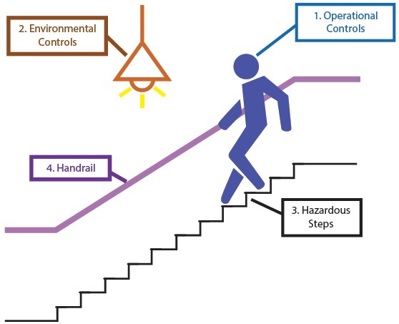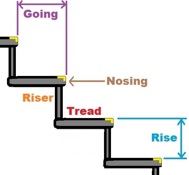Safer Work Stairs and Steps
Our 30 minute Safer Stairs and Steps online course, CPD Approved, provides advice on the key hazards, including four types of hazardous step and provides advice on the four holistic elements of safer stairs and steps. It provides practical checks for the workplace like the crouch-and-sight test, the foot fit test, visual contrast checks and the step check.
The Safer Work Stairs and Steps Information Sheet provides practical advice on four interdependent elements of safer stairs and steps - no one element should be considered in isolation.
- Every working day one person is hurt in a slip, trip or fall on work stairs or steps
- Descending is associated with many accidents
- Slips are more common (than trips or falls)
 |
In 2018 and 2019, Inspectors found that 18% of over 1,200 workplace visits had slips, trips and falls on stairs/ steps not included in the risk assessment. The rate was 52% in Retail. |

1. Operational Controls
Operational Controls are the rules and policies around the use of stairs and steps. Operational controls are important because "people have a low risk-perception of using the stairs, which causes people to ...perform unsafe behaviours".
- See the Safer Work Stairs and Steps Information Sheet for advice
|
|
In 2014, 71% of over 500 HSA workplace visits found no activities restricted on stairs, steps. The rate improved to 16% in 2020. This overall trend is mirrored in Manufacturing and Construction. There was no change in the Retail rate. (Inspectors conducted over 1,000 workplace visits in total.) |

- Users should remove/replace spectacles if required
2. Environmental Controls
Environmental Controls refer to the visual cues around stairs and steps
- See the Safer Work Stairs and Steps Information Sheet for advice
- Provide lighting of at least 100 lux at the tread
- Consider photoluminescent step edges/ nosings and handrails for emergency stairs/ step(s)
- Consider a different-coloured step edge/ nosing at the top and bottom steps for last step confirmation
Visual Contrast and Visual Contrast Checks
Contrasting step edges/nosings and handrails are about lightness or darkness, not colour. Colours that look different may have little visual contrast.
- Check the Light Reflectance Value (LRV) of adjoining surfaces with information from the manufacturer/ supplier. Ensure an LRV difference of at least 30 between adjoining surfaces for visual contrast
- A black and white image can provide a useful indication of the visual contrast
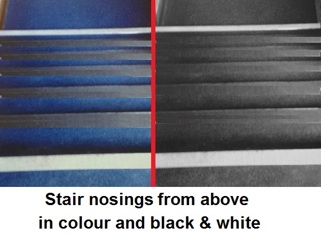
|
In 2014, 31% of relevant HSA workplace visits found stairs did not have clearly visible contrasting nosings |
3. Hazardous Steps
There are 4 types of hazardous steps – Slippery, Surprise, Short and Irregular.
- See the Safer Work Stairs and Steps Information Sheet for advice
a) Slippery Step
A slippery step does not have enough grip, especially at the step edge/nosing.
- See the Safer Work Stairs and Steps Information Sheet for advice
- Signs should only be used where hazards cannot be avoided or reduced
- On level surfaces, people generally slip on wet surfaces or wet shoes
- On stairs or steps, people could slip if there in inadequate support for the ball of the foot - see Short Steps
b) Surprise Step
A surprise step is not clearly visible or expected. It could be at the bottom of a flight or a single unexpected step.
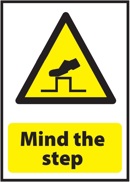
- See the Safer Work Stairs and Steps Information Sheet for advice
- Signs should only be used where hazards cannot be avoided or reduced
- Marking more than one step with warning stripes could be visually confusing and ineffective
c) Short Step
A short step does not provide adequate support for the ball of the foot for safe forward-facing descent.

- See the Safer Work Stairs and Steps Information Sheet for advice
- Signs should only be used where hazards cannot be avoided or reduced
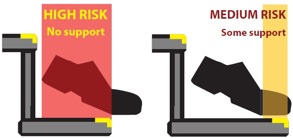
- The average male shoe is 290mm long
- Building Control Authorities, not the Health and Safety Authority, enforce Building Regulations (including going lengths)
d) Irregular Step
An irregular step is longer or shorter than the other steps in a flight.
- See the Safer Work Stairs and Steps Information Sheet for advice
- Signs should only be used where hazards cannot be avoided or reduced
- On 250mm goings, a large overstep occurs every 10 days
- With one 250mm going reduced by 15mm (less than a one cent coin), a large overstep occurs every 2 days
- On 300mm goings, a large overstep occurs every 73 years
- With one 300mm going reduced by 15mm (less than a one cent coin), a large overstep occurs every 3 years
- Marking more than one step with warning stripes could be visually confusing and ineffective
|
In 2016, 96% of relevant HSA construction workplace visits found the main site contact had not heard of the Crouch-and-Sight test |
4. Handrails
See the Safer Work Stairs and Steps Information Sheet for advice

Consider a handrail on the right-hand-side for descent
- Descending is associated with many accidents
- Most people are right-handed
When Considering Changes
When considering changes, it may be helpful to edit an image to illustrate proposed changes beforehand

See our 30 minute Safer Stairs and Steps CPD Approved online course
See Stairs, Steps Further Information

